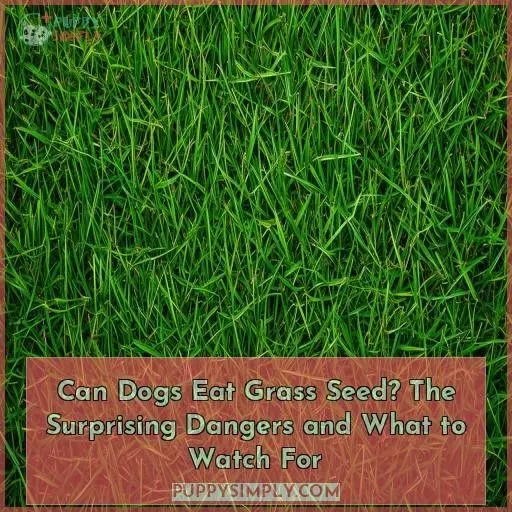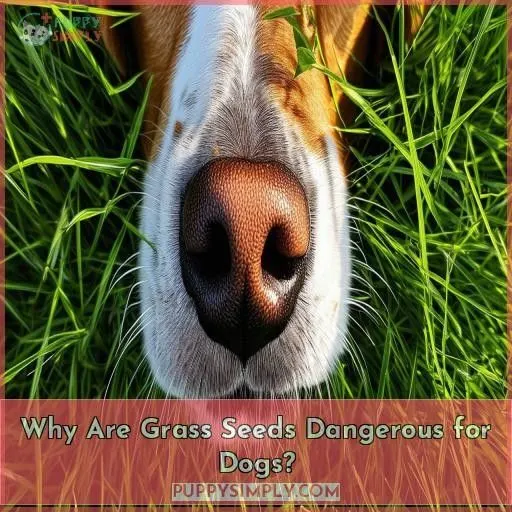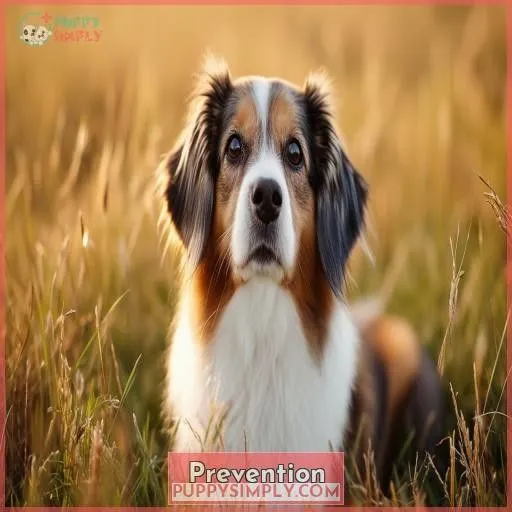This site is supported by our readers. We may earn a commission, at no cost to you, if you purchase through links.
 While dogs may nibble on grass seeds innocently, you’ll want to prevent them from eating them.
While dogs may nibble on grass seeds innocently, you’ll want to prevent them from eating them.
The sharp, arrow-shaped grass seeds are incredibly hazardous for our furry friends. If ingested, they can pierce the digestive tract, causing infections and potentially damaging internal organs.
Not to mention, they easily get lodged in paws, noses, and eyes, leading to painful swelling and inflammation.
So keep a close eye on your pup when outdoors, and promptly remove any grass seeds you find. Taking preventative measures will save you and your canine companion a lot of discomfort.
But don’t worry, we’ll go over how to properly treat grass seed injuries next.
Table Of Contents
- Key Takeaways
- Can Dogs Eat Grass Seed?
- What Are Grass Seeds?
- Why Are Grass Seeds Dangerous for Dogs?
- What Are the Symptoms to Look Out For?
- What Happens if a Dog Eats Grass Seeds?
- Symptoms of Secondary Issues
- Treatment After Vomiting
- What is the Treatment for a Grass Seed Injury?
- Prevention
- Frequently Asked Questions (FAQs)
- What happens if my dog ate grass seeds?
- Is grass seed dog safe?
- Is Scott’s grass seed toxic to dogs?
- Can dogs eat freshly mowed grass?
- Can dogs eat grass seed without getting sick?
- What happens if a dog eats too much grass seed?
- How long after eating grass seed will a dog vomit?
- Can grass seed cause long-term health problems in dogs?
- Are there any dog breeds more prone to grass seed issues?
- Conclusion
Key Takeaways
- Like a stealthy intruder, grass seeds can silently work their way into your pup’s body, causing a world of hurt. Don’t let their innocent appearance fool you – these tiny arrows pack a serious punch!
- Your canine companion may be tempted to munch on those verdant blades, but beware – ingesting grass seeds is a recipe for digestive distress. It’s like letting them eat a prickly cactus for dinner!
- Think of grass seeds as nature’s little booby traps, just waiting to snag your furry friend’s delicate paws, nose, or eyes. A few simple precautions, like avoiding tall grass and regular grooming, can save you both a heap of trouble.
- If you suspect your pooch has tangled with these botanical menaces, don’t hesitate – a swift visit to your trusty vet could mean the difference between a minor hiccup and a major health crisis. Better safe than sorry when it comes to protecting your furry family member!
Can Dogs Eat Grass Seed?
No, dogs shouldn’t eat grass seed. Grass seeds are shaped like darts with pointed ends that can easily penetrate a dog’s skin and burrow into their body, causing painful infections, abscesses, and even life-threatening complications if they migrate to critical organs (Source). Ingesting grass seeds can also lead to vomiting, loss of appetite, and other digestive issues in dogs .
What Are Grass Seeds?
Grass seeds are the small, sharp-pointed fruits of grasses that have developed to disperse efficiently. Their arrow-shaped structure allows them to easily attach to fur and clothing, aiding in their spread.
These seeds originate from the flowering heads of grasses, which develop after pollination. Their barbed awns help them burrow into the soil, ensuring the seed germinates in a suitable location.
In nature, grass seeds are an important food source for many animals. However, in regard to our canine companions, these seemingly harmless seeds can pose a serious threat.
Understanding the dangers grass seeds pose to dogs is essential for their well-being.
Why Are Grass Seeds Dangerous for Dogs?
Grass seeds pose a serious threat to your dog’s health due to their sharp, arrow-shaped ends that can easily penetrate the skin and burrow deep into the body.
Once embedded, these seeds can cause severe pain, inflammation, and even life-threatening infections.
As your dog moves around, the seeds can work their way further into the skin, potentially reaching vital organs or the lungs, leading to pneumonia.
The pointed edges make it nearly impossible for the seeds to work their way back out on their own.
Grass seed attachment and embedment are common causes of head shaking, infection, and internal tissue damage in dogs.
Staying vigilant and taking preventive measures is essential to keep your furry friend safe from these dangerous intruders.
What Are the Symptoms to Look Out For?
You’ll want to keep an eye out for signs that a grass seed has become embedded in your dog’s body. Common symptoms include bloody nasal discharge, sneezing, eye swelling and redness, licking or chewing at the skin, limping, and swelling of the legs or paws.
Nose: Bloody Discharge, Sneezing, Rubbing, Breathing Difficulties
Bloody nose discharge, frequent sneezing and nose rubbing, and severe breathing difficulties may indicate a grass seed lodged in your dog’s nose. Seek veterinary care promptly.
Eyes: Swelling, Redness, Watering, Ulcers, Blindness
Grass seeds can cause eye damage, corneal ulcers, and even blindness. Swelling, redness, watering, and ulcers require emergency treatment to prevent vision loss and potential eye removal.
Skin: Licking, Chewing, Swelling, Redness, Pus
If your dog’s skin is irritated, swollen, red, or oozing pus, a grass seed may be the culprit. Licking and chewing the area can lead to localized infection and delayed wound healing. Consult your vet for proper pain management and treatment to prevent allergic reactions.
Feet: Swelling, Redness, Limping, Leg Pain
If you notice your dog licking their paws excessively, or limping with redness, swelling, or leg pain, it could be due to grass seed-related issues. Prompt grooming and a vet’s attention are essential.
- Excessive paw licking
- Limping and reluctance to walk
- Swollen and painful paw or leg
- Redness and inflammation
- Visible grass seed between toes or in paw pads
What Happens if a Dog Eats Grass Seeds?
When a dog ingests grass seeds, the risks can be significant.
These small seeds, common in late spring and summer, aren’t to be underestimated. Once consumed, grass seeds can lead to various issues like irritation, infection, and even organ damage. In some cases, they may require surgical intervention for removal.
To avoid such complications, preventive measures are imperative. Regularly grooming your dog and checking for grass seeds after walks can make a substantial difference in preventing grass seed-related problems. By keeping your dog away from areas with tall grass and maintaining a well-manicured yard, you can reduce the risks associated with grass seed ingestion.
Early detection and intervention play key roles in safeguarding your furry companion’s well-being.
Symptoms of Secondary Issues
If your dog has ingested grass seeds or a fertilizer-grass seed mix, watch closely for symptoms like lethargy, pale gums, loss of appetite, or diarrhea lasting over 12 hours. These could indicate secondary issues requiring prompt veterinary attention.
Symptoms of Secondary Issues
Symptoms of secondary issues may include lethargy, pale gums, loss of appetite, diarrhea, and persistent vomiting. Seek immediate veterinary care if any of these develop .
- Difficulty eating or drinking
- Blood in urine or difficulty urinating
- Airway blockage or ear infection
Ingested Grass Seed Risks
Ingested grass seeds can cause digestive impaction, requiring prompt treatment with hydrogen peroxide. Consult MSDS sheets for specific risks. Seek veterinary care if skin irritation or inflammation persists.
Fertilizer Mix Impacts
Fertilizer type and product ingredients are vital. Use safe lawn products labeled pet-friendly. Induce vomiting within 1-2 hours if ingested. Monitor for symptoms requiring veterinary care and possible surgery.
Grass Seeds Prevalence
Grass seeds are most prevalent in late spring to end of summer, found in long grass where they stick to the fur and lodge in various body areas. They can cause open sores and permanent internal or external damage. It’s essential to avoid areas with long grass and conduct post-walk checks. (Source)
Treatment After Vomiting
After your dog has vomited up any ingested grass seeds or fertilizer, you should resume feeding their normal dry food. However, it’s recommended to provide a bland diet of boiled chicken and rice for the next 24 hours to allow their digestive system to recover.
Resume Feeding Normal Dry Food After Vomiting
After vomiting, resume feeding your dog their normal dry food. Monitor for continued issues. If vomiting persists, repeat the hydrogen peroxide treatment once. Seek veterinary care if symptoms develop. Regular grooming and hair trimming around the paws, ears, and armpits can help prevent grass seed ingestion and vomiting.
Bland Diet (chicken and Rice) is Recommended for 24 Hours
After vomiting, resume your dog’s normal dry food. For the next 24 hours, feed a bland diet of boiled chicken and rice to soothe their stomach. This gentle diet promotes recovery and prevents further digestive upset. Avoid rich or fatty foods, which can worsen symptoms. Monitor your pup closely and consult your vet if vomiting persists or other issues arise, such as:
- Loss of hearing
- Ruptured eardrum
- Corneal ulcers
- Loss of eyesight
- Inflamed tonsils
What is the Treatment for a Grass Seed Injury?
If your dog has sustained a grass seed injury, prompt treatment is essential. For mild cases, the vet may extract the seed with tweezers and prescribe antibiotics and anti-inflammatories, but severe cases often require anesthesia, surgery, and extensive post-operative care to address potential complications like eye damage, lung infections, or digestive tract issues.
Mild Cases: Extraction With Tweezers, Antibiotics, Anti-inflammatories
For mild cases, remove grass seeds with tweezers, apply antibiotic ointment, and give anti-inflammatory medication. Regularly groom your pet to prevent matted hair and licking.
| Antibiotic Effectiveness | Home Treatment Options | Veterinary Care Costs |
|---|---|---|
| Reduces infection risk | Tweezers, ointment | Avoid high expenses |
| Speeds healing | Anti-inflammatory meds | Seek care if needed |
Severe Cases: Anesthesia, Surgery, Antibiotics, Anti-inflammatories
For severe cases, your vet may recommend anesthesia, surgery, antibiotics, and anti-inflammatories to safely remove grass seeds and prevent complications like infection or organ damage .
- Anesthesia makes sure your dog’s comfort and safety during the procedure
- Surgery allows the vet to locate and remove deeply embedded seeds
- Antibiotics prevent and treat infections caused by the grass seed
- Anti-inflammatories reduce pain and swelling after the procedure
Eye Damage: Further Treatment and Medication
If a grass seed lodges in your dog’s eye, it can cause painful eye infections, corneal ulcers, uveitis, glaucoma, and even cataracts requiring veterinary treatment and medication.
Lung Infection: Chest Infection, Pneumonia, Collapsed Lung
Pneumonia, chest infection, and collapsed lung require veterinary intervention. Immediate treatment is essential to address respiratory infection, lung abscess, coughing up blood.
Digestive Tract Damage: Spread of Infection, Organ Damage
Grass seeds can spread infection through the digestive tract, potentially causing organ damage. Seek prompt veterinary care if your dog ingests grass seeds.
| Digestive Tract Damage | Potential Consequences |
|---|---|
| Spread of Infection | Organ Damage |
| Intestinal Blockage | Perforation |
| Peritonitis | Sepsis |
| Abscess Formation | Fistula Development |
| Chronic Inflammation | Malabsorption |
Prevention
You should take preventive measures to protect your furry friend from the dangers of grass seeds. Avoid walking in areas with long grass, keep your dog’s fur trimmed, and thoroughly check for any embedded seeds after outdoor activities.
Avoid Walking in Long Grass
Steer clear of long grass when walking your pup to prevent painful grass seed injuries. Stick to mowed lawns and pet-friendly areas instead (Source).
- Avoid areas with tall grass or grass seeds
- Consider using a grass seed barrier spray
- Examine dogs after walks
- Groom dogs regularly
Grass seeds can easily penetrate your dog’s skin and burrow into their body, causing inflammation, abscesses and infection . To keep your pup safe, always walk them in short, mowed areas and regularly check their fur for any stray seeds after outdoor adventures. Applying a grass seed barrier spray to their coat before walks provides an extra layer of protection. If you notice your dog licking, chewing or limping, carefully inspect their paws, ears and skin for any signs of grass seed irritation. Catching the problem early makes removal easier and reduces the risk of serious complications. With a few simple precautions, you can keep your furry friend happy and healthy all summer long!
Cut Grass in Yard Regularly
To prevent grass seed-related injuries, regularly mow your yard to keep the grass at the ideal height for your specific grass type and climate zone.
Trim Excessive Hair Around Paws, Ears, and Arm Pits
Trim your dog’s fur around paws, ears, and armpits to prevent grass seeds from getting stuck. Use grooming tools for a safe, effective trim .
Groom Dog Regularly
Groom your dog regularly to remove loose hair and prevent grass seeds from getting stuck in their coat. Use the right brushes and tools for their breed and coat type.
| Breed | Grooming Frequency | Hypoallergenic |
|---|---|---|
| Poodle | Weekly | Yes |
| Labrador | Bi-weekly | No |
| Maltese | Daily | Yes |
| German Shepherd | Weekly | No |
| Shih Tzu | Daily | Yes |
Check for Grass Seeds After Every Walk
After every walk, thoroughly check your dog’s fur for grass seeds. Regular grooming and clipping helps prevent painful infections from early seed detection .
Frequently Asked Questions (FAQs)
What happens if my dog ate grass seeds?
Like a double-edged sword, grass seeds pose a hidden danger – their sharp tips can pierce and burrow, leaving infection to fester. If ingested, they risk digestive distress, impaction, and surgical removal. Vigilance is key to keep your furry friend safe.
Is grass seed dog safe?
No, grass seed isn’t safe for dogs. It can cause obstructions and digestive issues, so avoid letting your pup ingest it.
Is Scott’s grass seed toxic to dogs?
While Scott’s grass seed products are unlikely to be toxic in small amounts, it’s best to discourage your dog from ingesting them. The ingredients, like fertilizers and mulch, could upset your pup’s stomach or cause an intestinal blockage. Monitor closely for any concerning symptoms.
Can dogs eat freshly mowed grass?
You wouldn’t steal your dog’s food, would you? Yet letting them munch on freshly mowed grass is like snatching a meal right from their bowl. It’s a risky feast that’s better left untouched.
Can dogs eat grass seed without getting sick?
No, dogs shouldn’t eat grass seed. It can cause digestive blockages and punctures if ingested. Keep your dog away from areas with loose seeds and keep their fur groomed to prevent seed attachment.
What happens if a dog eats too much grass seed?
With grass seed ingestion, the main danger is impaction. Too many seeds can clog your pup’s digestive tract, like a rock in a pipe. Vomiting, lethargy, and lack of appetite signal trouble ahead – contact your vet right away for guidance.
How long after eating grass seed will a dog vomit?
Within 1-2 hours, you’ll likely see vomiting if your dog ate a large amount of grass seed. But don’t wait – induce vomiting yourself using hydrogen peroxide and seek vet care if symptoms persist.
Can grass seed cause long-term health problems in dogs?
Yes, grass seeds can lead to long-term issues in dogs if left untreated. They may migrate to important organs, causing infections or obstructions requiring surgery. Early detection and removal is crucial for preventing serious complications.
Are there any dog breeds more prone to grass seed issues?
Yes, longer-haired breeds like Poodles, Shih Tzus, and Terriers are more prone. Their fur traps seeds easily, allowing them to travel deep into the coat.
Conclusion
Like a prickly thorn in your paw, grass seeds can cause serious harm if ingested by dogs.
Avoiding areas with tall grass, regularly grooming, and promptly treating injuries are crucial preventative measures.
While can dogs eat grass seeds may seem harmless, the risks of internal damage and infection are simply too great.
Stay vigilant, and seek veterinary care if you suspect your furry friend has encountered these pesky plant projectiles.














